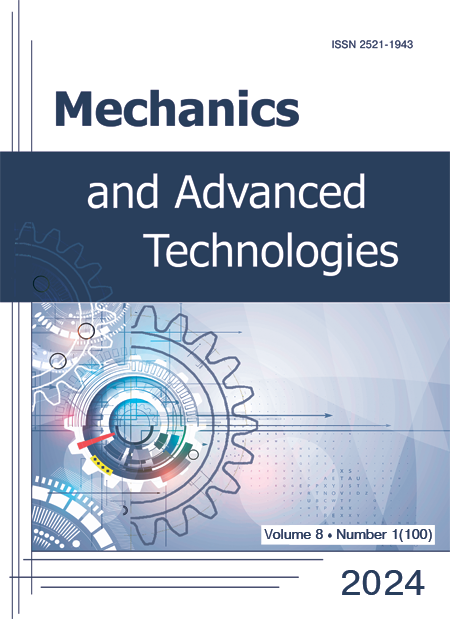Structure and properties of samples made from XH50BMTJuB-VI (EP648-VI) alloy produced by using selective laser melting process
DOI:
https://doi.org/10.20535/2521-1943.2024.8.1(100).297219Keywords:
additive processes, selective laser melting, hot isostatic pressing, vacuum heat treatment, a heat-resistant nickel alloy, the γ΄-phase, the α-Cr phaseAbstract
The paper presented examines the composition, the structure and properties of samples made from the XH50VMTJuB-VI (hereinafter EP648-VI) alloy obtained by using the selective laser melting process (the SLM-process) in relation to manufacturing parts for aviation purposes. The authors carried out a comparative study of the samples’ structure and properties upon conducting such operations as depositing in two directions (horizontal and vertical), separate heat treatment and after hot isostatic pressing (HIP) followed by a standard heat treatment process applied for deformable semi-finished products made from the XH50VMTJuB-VI
(EP648-VI) alloy. The authors inform that the manufacturing of samples by means of the SLM-process involved powders obtained through the technology of the vacuum-induction spraying of the molten metal jet with an inert gas (argon). The paper has established that samples obtained by using the HIP process with the application of the heat treatment (a vacuum high-temperature homogenization followed by a long-term aging) demonstrated the best set of mechanical properties, since the implemented complex process ensured the “healing” of pores and discontinuities in the structure, and strengthening by means of the intermetallic g¢-phase, while separations of the excess, needle-shaped a -Cr phase are fine and evenly distributed in the material structure. The authors noted that mechanical properties of samples under analysis were generally in compliance with the requirements set forth in the regulatory documentation for deformable semi-finished products made from the XH50VMTJuB-VI (EP648-VI) alloy, while underlining the increase in the level of impact strength of samples that underwent the HIP process, and the long-term strength of samples manufactured in the vertical direction compared to other options studied. Following the results of the analysis, the authors established that the SLM-process made it possible to manufacture products whose level of mechanical properties was close to the level of the deformable material, and even exceeded it in some cases.
References
- 20,000 3D Printed Parts Are Currently Used on Boeing Aircraft as Patent Filing Reveals Further Plans. Accessed: March 7, 2015 [Online]. Available: https://3dprint.com/48489/boeing-3d-print
- 3-D-Printed Parts Prove Beneficial for Airbus and ULA. Accessed: May 18, 2015 [Online]. Available: https://aviationweek.com/aerospace/3-d-printed-parts-prove-beneficial-airbus-ula
- GE’s Additive Manufacturing (3D Printing) Research Center [Online]. Available: https://gereports.com/post/102897646836/ges-additive-manufacturing-3d-printing-research
- Rolls-Royse Building First XWB-97 for Flights Tests [Online]. Available: https://aviationweek.com/air-transport/rolls-royce-building-first-xwb-97-flight-tests
- GE’s considers 3D printing Turbine Blades for next generation Boeing 777X’s GE9X Engines [Online]. Available: https://3dprint.com/11266/3d-printed-lpt-ge9x-777x
- NASA tests limits of 3-D printing with powerfull rocket engine check [Online]. Available: https://www.nasa.gov/news-release/nasa-tests-limits-of-3-d-printing-with-powerful-rocket-engine-check/
- Hot-fire tests show 3-D printed rocket parts rival traditionally manufactured parts [Online]. Available: https://www.nasa.gov/technology/manufacturing-materials-3-d-printing/hot-fire-tests-show-3-d-printed-rocket-parts-rival-traditionally-manufactured-parts/
- S. L. Campanelli, N. Contuzzi, A. Angelastro and L. A. Domenico, “Capabilities and Performances of the Selective Laser Melting process”, in New trends in Technologies: Devices, Computer, Communication and Industrial Systems, 2010, pp. 233–252. DOI: https://doi.org/10.5772/10432.
- Laser Additive Manufacturing of Turbine Components, Precisely and Repeatable. Accessed: May 20, 2011 [Online]. Available: https://lia.org/blog/category/laser-insights-2/laser-additive-manufacturing
- H. Brodin, O. Andersson and S. Johansson, “Mechanical Behaviour and Microstructure Correlation in a Selective Laser Melted Superalloy”, in Volume 5A: Industrial and Cogeneration; Manufacturing Materials and Metallurgy; Marine; Microturbines, Turbochargers, and Small Turbomachines. San Antonio, Texas, USA, 3-7 June 2013. DOI: https://doi.org/10.1115/GT2013-95878.
- J.-P. Kruth, M. Badrossamay, E. Yasa, J. Deckers, L. Thijs, J. V. Humbeeck, “Part and material properties in selective laser melting of metals”, Proceedings of the 16th Symposium on Electromachining, pp. 1–12, April 2010.
- F. Wang, “Mechanical property study on rapid additive layer manufacture Hastelloy® X alloy by selective laser melting technology”, International Journal of Advanced Manufacturing Technology, vol. 58 (5-8), pp. 545–551, 2012. DOI: https://doi.org/10.1007/s00170-011-3423-2.
- A. Mostafa, I. P. Rubio, V. Brailovski, M. Jahazi and M. Medraj, “Structure, Texture and Phases in 3D Printed IN718 Alloy Subjected to Homogenization and HIP Treatments”, Metals, vol. 7, no. 6, p. 196, 2017. DOI: https://doi.org/10.3390/met7060196.
- J. Dutkiewicz, Ł. Rogal, D. Kalita, K. Berent, B. Antoszewski, H. Danielewski, M. St. Węglowski, M. Łazińska, T.Durejko and T. Czujko, “Microstructure and Properties of Inconel 625 Fabricated Using Two Types of Laser Metal Deposition Methods”, Materials, vol. 13, no. 21, p. 5050, 2020. DOI: https://doi.org/10.3390/ma13215050.

- X. Wang and K. Chou, “Electron Backscatter diffraction analysis of Inconel 718 parts fabricated by selective laser melting additive manufacturing”, JOM, vol. 69 (2), pp. 402–408, 2017. DOI: https://doi.org/10.1007/s11837-016-2198-1.
- T. Antonsson and H. Fredriksson, “The effect of cooling rate on the solidification of Inconel 718”, Metallurgical and Materials Transactions B, vol. 36 (1), pp. 85–96, 2005. DOI: https://doi.org/10.1007/s11663-005-0009-0.
Downloads
Published
How to Cite
Issue
Section
License
Copyright (c) 2024 Костянтин Балушок, Олександр Селіверстов, Олексій Педаш, Наталія Лисенко

This work is licensed under a Creative Commons Attribution 4.0 International License.
Authors who publish with this journal agree to the following terms:
- Authors retain copyright and grant the journal right of first publication with the work simultaneously licensed under CC BY 4.0 that allows others to share the work with an acknowledgement of the work's authorship and initial publication in this journal.
- Authors are able to enter into separate, additional contractual arrangements for the non-exclusive distribution of the journal's published version of the work (e.g., post it to an institutional repository or publish it in a book), with an acknowledgement of its initial publication in this journal.
- Authors are permitted and encouraged to post their work online (e.g., in institutional repositories or on their website) prior to and during the submission process, as it can lead to productive exchanges, as well as earlier and greater citation of published work











